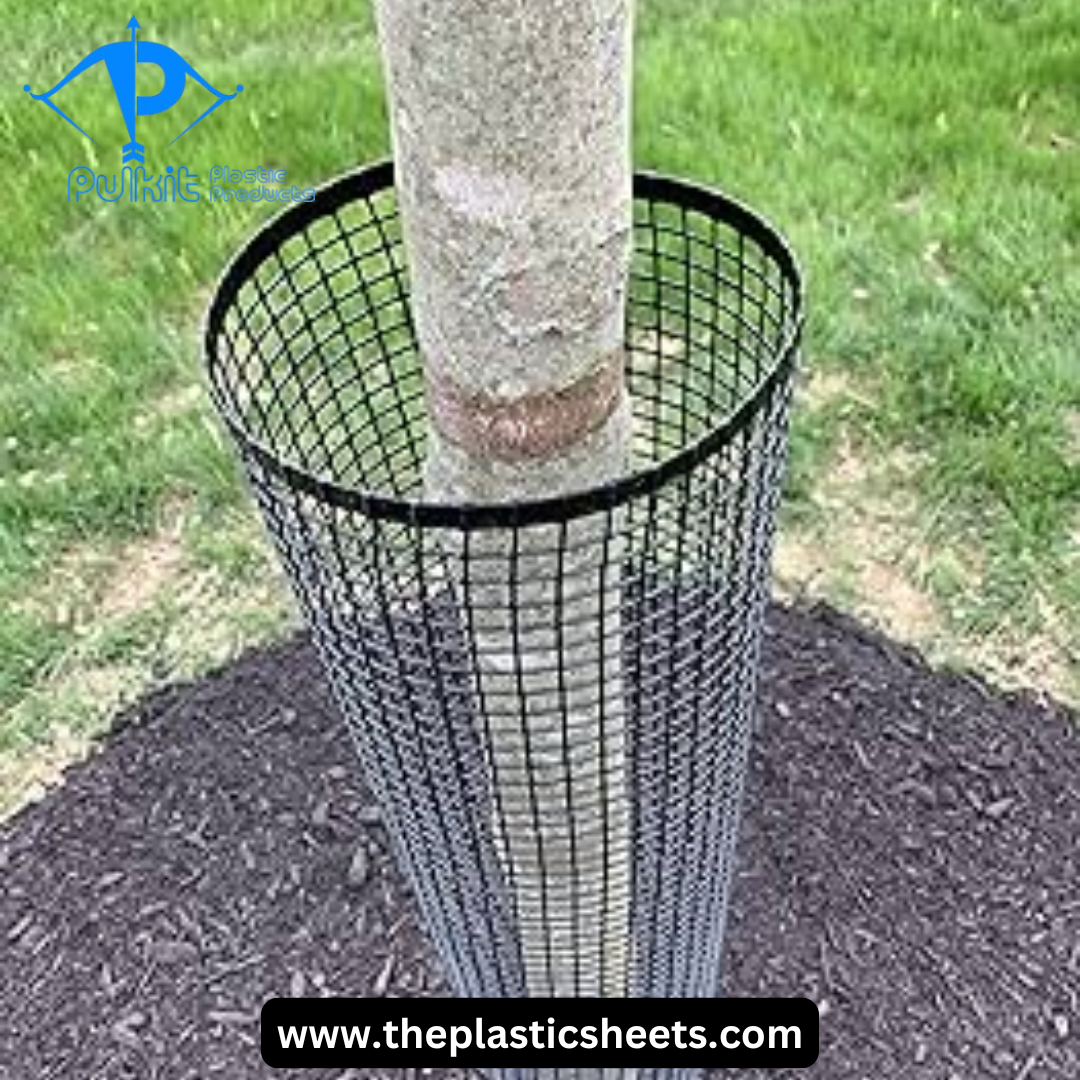Trees are vital to the environment, providing oxygen, improving air quality, conserving water, and supporting wildlife. However, newly planted trees, especially in urban and rural areas, face several threats. They are vulnerable to damage from animals, harsh weather conditions, and human activities. To safeguard these trees during their formative years, the use of tree guards has become increasingly popular. Among the many options available, plastic tree guards, particularly those made from durable materials like PVC and tree guard netting, are gaining favor due to their effectiveness, cost-efficiency, and ease of installation. This Pulkit Plastic Products delves into the benefits, uses, and growing demand for plastic tree guards, highlighting their role in tree conservation.
Table of Contents
ToggleWhat is a Plastic Tree Guard?
A plastic tree guard is a protective barrier designed to shield young trees from external harm. Typically made from PVC (polyvinyl chloride) or other sturdy plastics, these guards act as a fence around the tree, preventing damage from grazing animals, lawn maintenance tools, and environmental factors such as strong winds. The design of the plastic tree guard often includes a tree protection net, which provides ventilation while protecting the tree from physical damage. These guards come in various sizes, allowing them to be used for both saplings and slightly more mature trees.
Tree guards, including the popular Tree Guard Net, offer a simple yet effective solution for preserving the health of young trees. They ensure that the tree’s bark remains intact, preventing injuries that could lead to infection or stunted growth. Additionally, plastic tree guards help create a microenvironment around the tree that reduces wind damage and conserves moisture, fostering healthy growth.
Benefits of Using Plastic Tree Guards
The use of plastic tree guards offers several significant benefits, particularly in ensuring the long-term health and growth of trees. One of the key advantages is their ability to protect trees from animals. In rural and suburban areas, livestock, deer, and other grazing animals often pose a threat to young trees by nibbling on the bark or leaves, which can lead to permanent damage or even death of the tree. A sturdy PVC tree guard provides a physical barrier that prevents animals from accessing the tree, allowing it to grow without disturbance.
Another important benefit is protection from human activities. Whether it’s accidental damage from lawnmowers, bicycles, or pedestrians, young trees in urban areas often face unintended harm. A tree guard net can act as a visible and effective deterrent, reducing the chances of the tree being damaged. Additionally, plastic tree guards are lightweight and easy to install, making them a practical solution for large-scale tree planting projects.
Environmental factors such as wind, frost, and sun exposure can also harm young trees. Tree protection nets allow for air circulation while reducing direct exposure to these elements, which helps maintain a favorable microclimate around the tree. Furthermore, these nets help retain moisture in the soil, promoting healthy root development during dry periods.
Types of Plastic Tree Guards
There are various types of plastic tree guards available on the market, each designed to meet specific needs. One of the most common types is the PVC tree guard, which is highly durable and resistant to weathering. These guards are often used in both urban and rural environments because of their robustness and longevity. PVC tree guards are typically cylindrical and come in different heights, making them suitable for a range of tree sizes. Their rigid structure offers substantial protection against physical damage from animals and humans.
Another popular type is the tree guard net, which is often made from lighter, flexible plastic materials. These nets are designed to wrap around the tree trunk, offering protection while allowing for airflow and sunlight penetration. Tree guard nets are particularly useful in areas where airflow is important for preventing mold or fungus growth on the tree bark. Additionally, these nets are easy to remove and reposition as the tree grows, making them a flexible option for tree care.
Tree protection nets are also widely used in agricultural settings where there is a need to protect large numbers of trees from pests and grazing animals. These nets are often designed with a fine mesh structure to keep out smaller insects that can damage the tree bark. They can be customized to different lengths and widths, making them adaptable for various tree types and growth stages.
Applications of Plastic Tree Guards in Different Environments
Plastic tree guards are used in a variety of environments, from urban streets to rural farmland, to ensure that trees can grow without external interference. In urban areas, where space is limited and human activity is high, PVC tree guards are often used to protect young trees planted along sidewalks or in parks. These guards not only prevent accidental damage from passersby but also offer a level of aesthetic appeal, blending seamlessly into the urban landscape. Municipalities and city planners frequently rely on plastic tree guards for street tree planting initiatives, where protection is crucial for the survival of young saplings.
In agricultural settings, plastic tree guards play an important role in protecting orchards and other tree plantations. Farmers use tree protection nets to keep animals such as deer, rabbits, and livestock from feeding on young trees. These nets are especially beneficial for fruit trees, which are vulnerable to both animals and insects. The use of tree guard nets helps reduce the need for chemical pesticides and physical barriers, promoting a more environmentally friendly approach to tree care.
Plastic tree guards are also widely used in reforestation projects, where protecting large numbers of trees from wildlife is essential to the success of the endeavor. In these environments, tree guards can help saplings establish themselves by shielding them from both natural predators and harsh weather conditions. As climate change continues to impact ecosystems, reforestation projects have become increasingly important, and plastic tree guards are a key tool in ensuring the survival of new plantings.
Durability and Cost-Effectiveness of Plastic Tree Guards
One of the reasons plastic tree guards have become so popular is their durability and cost-effectiveness. PVC tree guards, in particular, are known for their ability to withstand the elements, including sun, rain, and wind, without deteriorating. This durability ensures that the tree guards can remain in place for several years, providing long-term protection for the tree as it grows. In comparison to metal or wooden tree guards, plastic tree guards are much lighter and less prone to rust or rot, making them a low-maintenance solution.
Moreover, Tree Protection Net are a cost-effective investment for municipalities, farmers, and environmental organizations. Due to their lightweight design, plastic tree guards are cheaper to produce and transport than their metal or wooden counterparts. This makes them an attractive option for large-scale tree planting efforts, where the cost of individual guards can quickly add up. Additionally, the ease of installation means that labor costs are minimized, allowing tree guards to be deployed quickly and efficiently in the field.
Environmental Impact and Sustainability of Plastic Tree Guards
While plastic is often associated with environmental concerns, plastic tree guards, particularly those made from recyclable PVC, can contribute to sustainable tree planting efforts. Many manufacturers now produce plastic tree guards using recycled materials, which reduces the need for virgin plastic production and minimizes the environmental footprint of these products. Furthermore, plastic tree guards themselves can be recycled at the end of their lifespan, contributing to a circular economy where materials are reused rather than discarded.
Another way in which plastic tree guards promote sustainability is by reducing the need for chemical pesticides and fertilizers. By providing a physical barrier that protects trees from pests and environmental stressors, plastic tree guards help trees grow healthier without the need for additional inputs. This not only benefits the trees but also reduces the impact of agriculture and urban landscaping on the surrounding environment.
Future of Plastic Tree Guards in Conservation and Urban Development
As urbanization and climate change continue to challenge tree growth and survival, the demand for effective tree protection solutions will only increase. Plastic tree guards, with their proven durability, cost-efficiency, and versatility, are well-positioned to meet this demand. Advances in material science and manufacturing processes are likely to lead to even more sustainable and innovative designs for plastic tree guards in the future. For example, biodegradable plastic tree guards made from plant-based materials could offer a new level of environmental friendliness, breaking down naturally once the tree no longer requires protection.
In urban development, plastic tree guards will continue to play a critical role in promoting green spaces and enhancing biodiversity. As cities around the world work to improve their air quality, reduce heat islands, and increase green coverage, protecting newly planted trees will be a priority. Plastic tree guards will be essential tools in ensuring that trees survive and thrive in these rapidly changing environments.
Conclusion
The PVC Tree Guard have become a vital tool in the protection and preservation of young trees, especially in areas where trees are vulnerable to damage from animals, humans, and environmental factors. The durability, cost-effectiveness, and versatility of plastic materials like PVC make these tree guards an ideal choice for a variety of applications, including urban landscaping, agriculture, and reforestation. With ongoing advancements in sustainability and design, plastic tree guards will continue to play an essential role in tree conservation efforts worldwide, supporting a greener and healthier planet.
Frequently Asked Questions (FAQs)
What is a plastic tree guard used for?
A plastic tree guard is used to protect young trees from damage caused by animals, humans, and environmental factors. They are commonly used in urban areas, agricultural settings, and reforestation projects to ensure that trees grow healthy and strong.
How does a tree guard net differ from a PVC tree guard?
A tree guard net is typically made from a flexible plastic mesh that allows for airflow while protecting the tree from physical damage. A PVC tree guard, on the other hand, is more rigid and provides stronger protection, especially in areas with larger animals or more significant environmental threats.
Are plastic tree guards environmentally friendly?
Many plastic tree guards are made from recyclable materials such as PVC, and they can be reused or recycled after use. Some manufacturers are also developing biodegradable tree guards to further minimize environmental impact.


